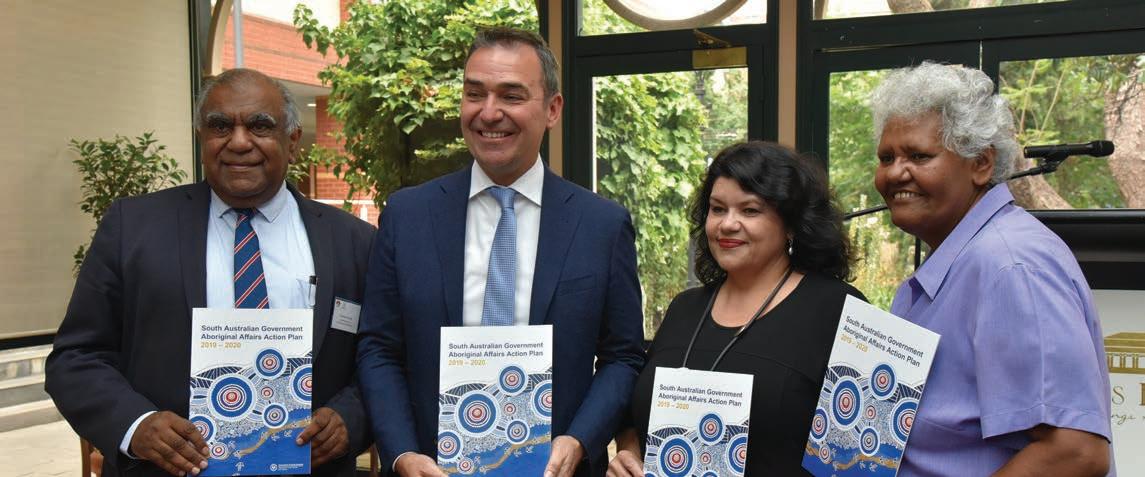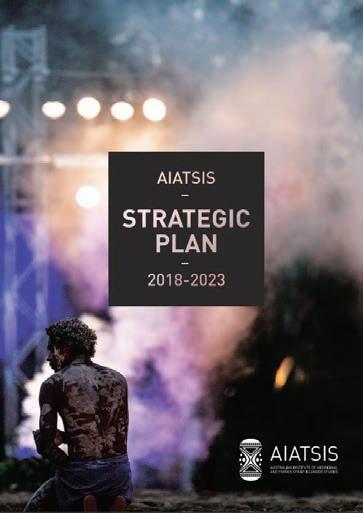
25 minute read
A Ngurra for Indigenous Australia in Canberra
The Australian Institute of Aboriginal and Torres Strait Islander Studies (AIATSIS) is calling for the development of a dedicated Aboriginal and Torres Strait Islander precinct in Canberra.
Craig Ritchie, the CEO of AIATSIS told Aboriginal Way that the bold idea is “an opportunity to invest in and to support Aboriginal and Torres Strait Islander people, to tell our story to the nation”. “We think that if you look at the way the national capital tells the story of Australia, the glaring omission is Aboriginal and Torres Strait Islander components of our national story” Mr Ritchie said.
Advertisement
The precinct would include a new home for AIATSIS, a National Indigenous Cultures and Knowledges Centre and a National Resting Place, which would be for repatriated ancestral remains that are not able to be returned to their own country.
“We think that it’s really important that there’s a national place that appropriately cares for, and respectfully cares for, our ancestral remains in that situation” Mr Ritchie said.
AIATSIS is working on collaborations to make the vision a reality. “We will be looking for partners who are keen to join with us in our vision of making sure that we live in a world where our cultures, our knowledges, and Torres Strait Islander people’s knowledge and cultures are recognised, respected, celebrated and valued” and through that to “help Australia forge a more inclusive national identity”.
“We have a real responsibility to be speaking to the nation about the first component of our strategic plan, to tell the story of Aboriginal and Torres Strait Islander Australia” Mr Ritchie said.
According to Mr Ritchie, the organisation’s ambitions to be more public comes at crucial time for Australia.
“It’s a really important time in the history of the nation, I think. It’s at a time when questions of who we are nationally, and national identity are front and centre in lots of people’s minds.
“You have on the one hand a fairly resurgent, conservative perspective on Australian national identity that positions our Australian identity as something that’s largely white, Anglo, and Christian.
“In an environment like that, there’s not a lot of room for migrant populations, there’s not a lot of room for Indigenous culture and heritage.
“We think we have a responsibility to work with Indigenous Australians and communities, to be able to make sure that our story is being told, and it’s being told by us, by Indigenous Australians” he said.
In this Year of Indigenous Languages, AIATSIS will also pursue what it calls a “Resurgence Initiative” that is about contributing to cultural resurgence across Aboriginal and Torres Strait Islander Australia.
“Over the next year or two, we will publish somewhere between 20 and 25 Indigenous language dictionaries” Mr Ritchie explained.
“That will become a really important tool and resource for communities and educators and academics to support the resurgence of Aboriginal languages, and Torres Strait Islander languages.
“It is absolutely critical to language revitalisation that you have a dictionary. Not just a word list, but a really good dictionary” he said.
AIATSIS will also focus on “transformation”, starting with young Australian students.
“It’s really healthy to transform people’s understanding about Indigenous Australia, and that will include a real focus on school education and curriculum issues, a well as supporting better teaching of Indigenous Australia’s history and cultures, in our school education in classroom context” Mr Ritchie said.
As part of that initiative, AIATSIS will produce textbooks and classroom resources for Australia primary schools.
“We think that if you don’t transform the way that Australians think about Indigenous Australia, and think about what really is the first story of this country, the 65,000 year old story of Indigenous Australia, then schools are a really critical vehicle for transforming people’s understanding” Mr Ritchie said.
In further educational activity, AIATSIS will offer a cultural awareness program to the corporate sector.
“That’s really about giving people the skills that they need in their professional life, to be able to engage respectfully with Aboriginal and Torres Strait Islander people. It’s a foundation course, it’s not meant to replace face to face engagement at a local level, which is absolutely critical. It’s meant to support and to drive that local engagement” said Mr Ritchie.
AITSIS is looking to use information technology to reach out from its Canberra base.
“This is really looking at options that are available to the institute to be genuinely national in our focus, and to think about how we can extend both our influence, but also our presence, physically and digitally across the country.
“And so we want to be working particularly with the states and the territories on what those options might look like, but also thinking about having the kind of online presence that means, even though we’re a Canberra based institution, we’re really trying to be everywhere” Mr Ritchie told Aboriginal Way. AIATSIS will also continue to work to raise the profile of Australian Indigenous people internationally Mr Ritchie said, with several research partnerships established with institutions across the UK, Canada and New Zealand.
As Australia’s Indigenous research organisation looks to the future, its CEO has also been looking to the past and the original reasons the organisation was established in the 60s.
“I read some of the speeches that were made in Parliament, in the debates in 1964 leading up to the passage of the first Act that established the institute. And one of the things that struck me about that was the sentiment expressed by several of the people who were speaking in Parliament” Mr Ritchie told Aboriginal Way. “They spoke about how important this institution is, not just to Aboriginal people, and not just to Australians, but to humanity at large. And I was really excited about that, I was a bit surprised, I’m going to say, that such sentiments were expressed in 1964.
But it really spoke to the role that the institute has, not just in relation to Indigenous people, but also to all Australians, but also internationally” he said.
are not only recognised and respected, but celebrated and valued.
“We’re talking to the Government about how important this is, what an opportunity this is to invest in and to support Aboriginal and Torres Strait Islander people, to tell our story to the nation.
“We’ll also continue to engage with the private sector, to try and generate support” he said.
AIATSIS has called the ambitious proposal the Ngurra Project.
“Ngurra is a word that it appears in many different Aboriginal languages around the country, that basically has the same meaning. It’s the word for ‘home’, ‘camp’, ‘a place of belonging’, ‘a place of inclusion’” Mr Ritchie said.
The proposal is a key initiative of the 55- year-old institution’s new strategic plan, which covers their priorities and activities for next five years. On launching the plan late last year, Mr Ritchie called AIATSIS “the nation’s best kept secret”.
He explained to Aboriginal Way that while AIATSIS is known to many people, the knowledge of the general public about the research institution is low.
“For stakeholders that have had a bit to do with the organisation, so the native title sector, for example, and the academy, museums and the cultural sector, people in those areas are fairly familiar with us.
“But in terms of people just generally, the general public, knowing ‘oh, there’s AIATSIS over there – what is it that you do? Are you part of the museum? Are you part of ANU?’ Many people just don’t know” he said.
“Fairly tight” funding has been a challenge for the organisation in recent years and that has influenced its public profile, Mr Ritchie said.
“We tended, I think, to be a fairly inwardfacing institution” he said.
The new strategic plan presents ambitions to change that. AIATSIS’ vision is to create “a world in which Aboriginal
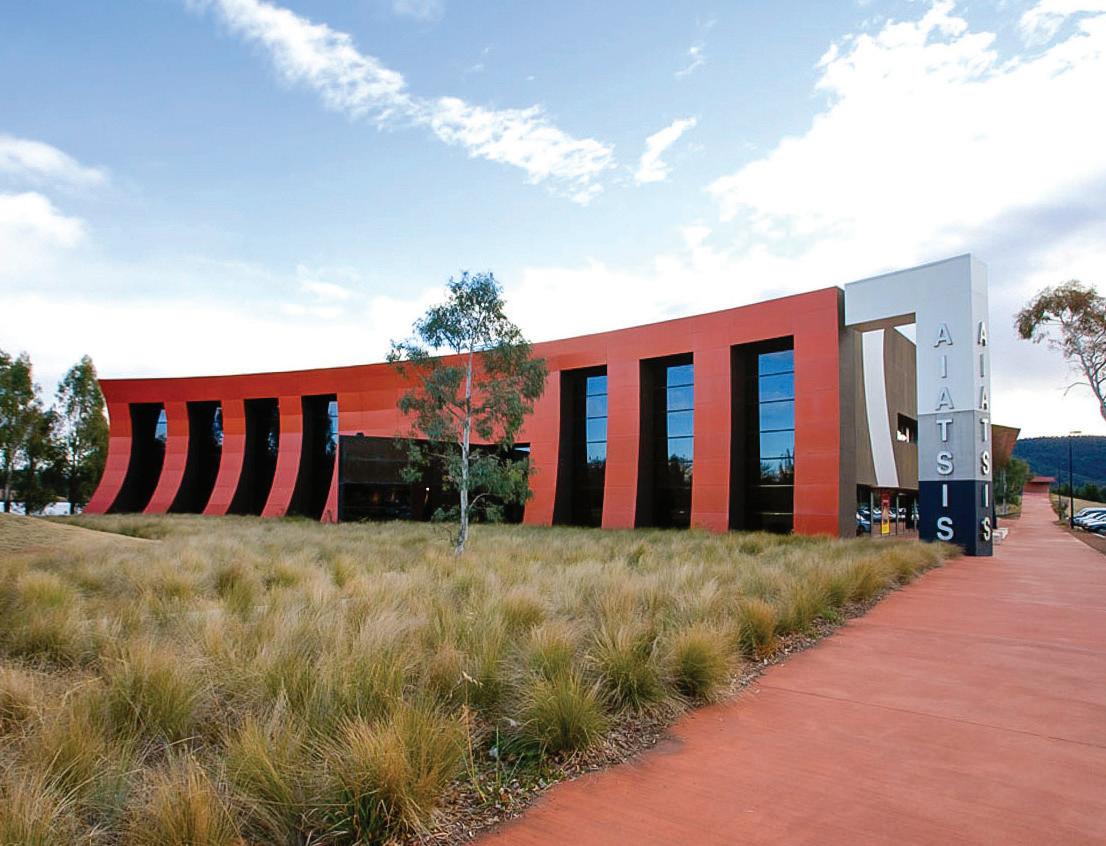
The AIATSIS Strategic Plan 2018–2023 is available on their website www.aiatsis.gov.au


Above, left: The NSW property “Millpost”. Centre: Ancient axe quarry site. Right: Dave Johston with Dr Chris Wilson from Flinders University.
The discovery of a site of significant Aboriginal heritage in New South Wales has brought farmers and traditional owners together in a rare collaboration.
Indigenous archaeologist and anthropologist Dave Johnston discovered an ancient axe quarry site on a NSW property called “Millpost” that has now been listed on the State’s special sites register.
Since then, the farmers of the property and the traditional owners of the area, the Ngunnawal and Nambri people, have cooperated to protect and promote the area.
It’s a rare collaboration because very few sites of significant Aboriginal heritage listed in NSW are on privately held land. It seems that for many years farmers have kept heritage discoveries on their property secret.
Last year, Dave Johnston told an audience at Flinders University about the site and the work that had been done to protect and promote it.
He spoke to Aboriginal Way after the event and explained how he came to identify the axe quarry site after being invited for a picnic by the property owners, the Watson family.
“We were invited out for a picnic with a group of friends, to go up to David Watson’s favourite place on the property, up on this hill where he grew up as a kid, it was his favourite place.
“He was hoping there might be something there. I looked around, I couldn’t see any evidence straight away, but I said, look, it’s a good visual point, you can see the Brindabellas and the various ranges around Canberra, into the valley, Millpost Valley.
“But then I looked around again as we were leaving, I thought what was a granite outcrop, I looked and saw this blue stone. I thought, oh, that’s a bit different, it’s been chipped too. And I thought, oh, a vehicle has chipped this big block. Then it just dawned on me as I looked around, this isn’t granite, it’s basalt, which is the most popular stone for making stone axes around the country.
“And I realised that this outcrop was basalt, not granite... and I could see it growing in my eyes, and as being a massive outcrop of basalt that has been quarried. And the axe blanks were there specifically for making axes, and it was an axe quarry site for the metadolerite” he said.
Mr Johnston had worked with the local Nambri and Ngunnawal communities in the area for over 35 years and so immediately spoke to them about the find at Millpost.
“So I thought, well here we are, we’ll stop here. We’ll go and contact the Elders. The farmers were keen to meet with the traditional owners, the custodians” he said.
Dave Johnston worked with the traditional owners, the farmers and the Office of Environment and Heritage New South Wales and the outcrop was recorded as “majorly significant Aboriginal site” and a special site for the state.
“Just recently the Minister in New South Wales declared it an Aboriginal place on their special list, that’s a separate list to just the general Aboriginal sites registrar. So it’s quite a significant find.
“It’s just such an important and great opportunity for the communities to come together and share and recognise and look after the place, which they’re doing” Mr Johston said.
The Watson farming family were happy to collaborate with the traditional custodians on protecting the site. It can be a rare attitude still for many pastoralists and property owners said Mr Johnston.
“The original false news was, you know, from a native title, came that Aboriginal peoples and farmers just couldn’t be friends, so to speak. Aboriginal people were going to steal their land through this native title. And all these false news and false stories that have gone on.
“The Watsons broke the mold in saying ‘well look, we actually want to know about the local community’”.
The Watsons have been on the property for five generations and expressed a respect for the Aboriginal people before them as well as an interest in the full history of the site.
“There are many histories, but if people who love country, their families, have an attachment to the land, and look, are worried and concerned about its future and their children’s future, who better than Aboriginal communities and property owners?” asked Mr Johnston.
“There are so many histories. And everyone has an angle of their history. But that is shared” he said.
Engaging with the site was also significant for local Ngunnawal and Nambri people, including Matilda House, Molly Bell and Carl and James Mundy.
“The Aboriginal people that came to the site, even though they hadn’t been out Millpost in their generation, finding the sites was part of their heritage.
“This is a process where people are coming together to say, hey, we actually do care about our local history and heritage, and if governments aren’t adequately, I would argue, looking after our heritage, Australia’s heritage and Indigenous heritage, then you know, the locals and good people can” Mr Johnston said.
The significant find at Millpost offers potential for tourism and other economic development, with people working in partnership,” said Mr Johnston.
“We’ve just run an Indigenous outreach program utilising that site and hospitality of the Watsons.
“It’s the start. Now we’re growing it, and we’re also looking, can we get some economic opportunities alternate for the farmers, having some cultural tourism both European and Aboriginal with the traditional owners working together in partnerships, and that’s what we’re starting. It can’t be everywhere do that, but it’s certainly working here” he said.
This particular site, while special in the way it has been managed, is not unique in terms of heritage across the nation explained Mr Johnston.
“Australia as a whole is a cultural landscape. Aboriginal people have been here for 65,000 plus years, their survival, everyone, you know, making tools, implements, that is our archaeology. That’s our physical remains that are there, our existence symbolising it.
“It’s our footprints in the sand, so to speak” said Mr Johnston. Mr Johnston said people have been unwilling share their findings on their property.
“In the past, property owners may have been reluctant to share their finds.
“Every farm would have a collection. However, it’s illegal to collect and destroy sites by collecting them, but in the old days everyone did it.
“So we always said, you know, every farmer has the best collection under the house. And that’s true. The difficultly is that there’s fears that ‘we’ve taken the artefacts, we might get sued’. Well, it is illegal now to do that, but the old collections prior to that legislation are fine.”
“For years, because they didn’t want black fellas coming in to take their land, so... But when they realised they don’t, there’s an opportunity for a conversation.
“that conversation has commenced, led by examples such as Millpost and changing attitudes among farmers,” Mr Johnston said.
“The ANU just the last couple of weeks have been running some workshops with farmers and Aboriginal groups about some of the collections they’ve had under their sheds, collected from years ago before the laws said it was illegal to do that.
“But more importantly the Watsons, and other farmers like that, are talking to their neighbours, talking to their family down the road, talking at the local shows.
“They are the better ones to let the other farmers know, ‘hey, this is a great relationship we’ve got here, we’ve got so much to gain and little to lose’.
“The other farmers will listen to the other farmers first. Breaking down those stumbling blocks that are actually just glass houses is wonderful to see, and watching the community grow in this way” Mr Johnston said.
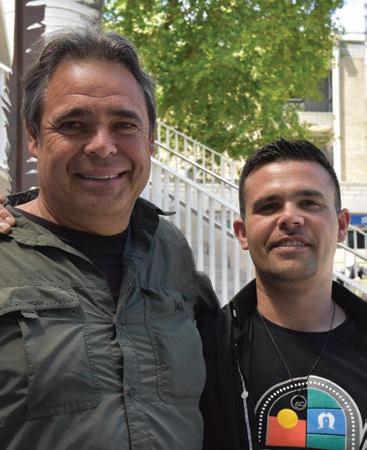
You can see a video about the Millpost project here: https://vimeo. com/184172289
A family stroll around the neighbourhood has sparked a growing grassroots initiative to pay respect to traditional owners
The Sign of Respect project distributes simple signs of acknowledgement to Kaurna people of the Adelaide area for people to place on their fences, and may spread further across Australia. The founder of A Sign of Respect Kate Rush says that the idea occurred to her after completing cultural respect training with Ngarrindjeri woman Sharon Gollan. “I had never been so aware of the fact that my white culture was having this influence on people and often that influence happened sub consciously because we don’t spend time thinking about the influence that we have on others.
“A lot of the time that influence has, obviously historically been full of tragedy and horrendous kind of history, but also the fact that today, on a day to day basis, we think and act a lot without thinking about the impact of our culture on others. “My partner and I were out walking our dog one day and we saw an old plaque that was acknowledging Aboriginal people as traditional owners and we thought, I wonder if we put a sign like that on our fence, it’s a way of making a public statement to people in our street about the fact that we value and recognise first nations people in our neighbourhood?” Ms Rush told Aboriginal Way. She had a good reaction to the sign from others in her area.
“It actually sparked a lot of interest from our neighbours asking, what was this sign all about and what were we doing and we explained that was just about giving respect where it was due” she said. That interest led Kate Rush and her family to look at extending the act of acknowledgement. “We started to realise that other people were quite interested in showing respect in a similar way. “My partner, who is a graphic designer, put together a flyer and we dropped them around the neighbourhood and we said, who wants a sign? And ended up giving away 10 signs quite quickly to people in our neighbourhood who were interested in doing that.” The signs garnered interest from both non-Aboriginal and Aboriginal people, Ms Rush said, and that created valued opportunities for connection. “Some of the people that we gave signs to through that process were local Aboriginal people that we hadn’t necessarily met before or connected with before as well as other neighbours that we hadn’t necessarily met either and it became a great way of hearing people’s experiences and what was important to them” she said. Once they had seen the interest, Ms Rush began to realise the initiative could grow and become more meaningful to a local community. “We spoke with Kaurna Elders, Aboriginal community and education groups, as well as broader community members” she said. From there they were encouraged to combine the simple sign with information about local country and culture. They enlisted Supply Nation accredited businesses, including Ochre Dawn to work with artist Allan Sumner and Print Junction to produce a new sign that could be distributed more widely. The project has become about much more than a sign on a front fence, Ms Rush says. “People were saying that it’s good to give something practical that people can do but we also want to make sure that people are encouraged to learn about Kaurna culture and to go on their personal journey of learning and respecting culture by understanding the culture that exists in the land that they live on or work on.
“Community members also started to create ways for that to happen very informally, so I had a neighbour pop over who I hadn’t met through the previous experience she said look, you know, I’ve organised a bit of a get together at the local café, why don’t you come along and talk about the sign and what it means and all those sorts of things. “So there is a real sense of community kind of helping to drive what the initiative looks like and how it sort of grew very organically if you like” Ms Rush said. A Sign of Respect operates as a social enterprise and is in the process of formally registering as a not-for-profit organisation that aims to be sustainable without reliance on government funding. The project now sells A Sign of Respect support packs online and at events, with any profits being reinvested into the project. The project has also formed a Community Advisory Group to gain input and support into the direction of the project. Through a new community based governance structure, the group will consider how to manage requests for signs for other people’s country. “We’ve had a lot of requests for signs that recognise other nations and I guess one of the things that we want to honour is the way in which A Sign of Respect came together over the last 12 plus months and make sure we go through the process of engaging and involving community through the development of any new signs or any new area or acknowledging any new country” said Ms Rush.
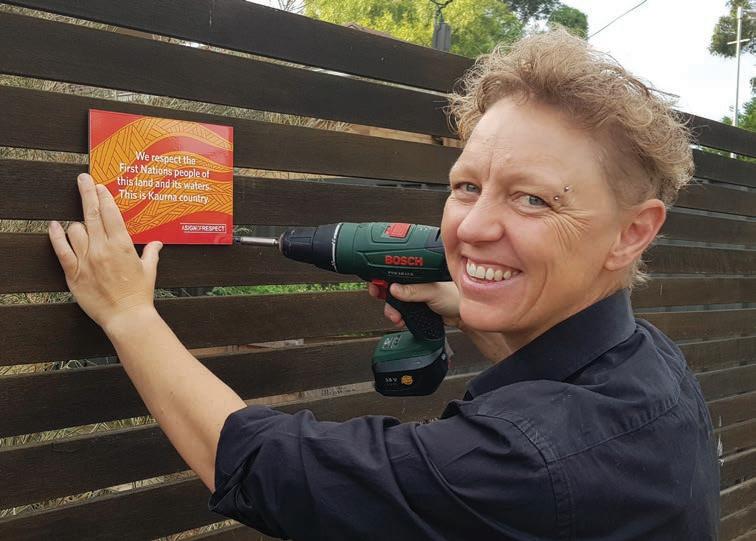
Kate Rush.
“Because that grass roots approach has been very important I think, not just in how it came together but also in how I think it will continue to grow and operate. What we want to do, is do it in a way that keeps a strong connection with community as it grows.”
You can find out more about A Sign of Respect at www.asignofrespect.com
SA Government’s plan for action
Late last year the South Australian Government announced the launch of its Aboriginal Action Plan to guide services and outcomes for the state’s Aboriginal people.
The Action Plan is the first of its kind and outlines 32 activities including; actions, priorities, desired outcomes and the Ministers and agencies responsible for them. Premier Steven Marshall launched the plan at an event at Ayers House in December 2018.
“Developed following engagement with Aboriginal community leaders and a coordinated across government effort, this plan will deliver positive and practical on-the-ground outcomes through 32 specific activities over the next two years” he said. Those activities include actions in the areas of apprenticeships and traineeships, Aboriginal Ranger employment pathways, Aboriginal employment in South Australia Police, Aboriginal Business Policy, Stronger Partners Stronger Futures, Municipal Services to Aboriginal Communities Strategy and South Australian Museum Aboriginal Collection Store. Each action has a nominated responsible Minister and lead agencies within the government identified.
“There will be regular updates on our progress so that we can identify what is working and just as importantly, what isn’t working” the Premier stated in the Plan.
“This will also provide a benchmark for continuous improvement in government policies and in the program sand services Aboriginal people and communities receive.”
Roger Thomas, Commissioner for Aboriginal Engagement was given a role in consulting about the proposed Action Plan before its release, and liaised with three selected Aboriginal agencies – the Aboriginal Lands Trust, the Aboriginal Heritage Committee and the South Australian Aboriginal Advisory Council – on the plan.
“I was asked by the Premier to save feedback from targeted stakeholders and to include in the feedback any potential and possible blockages and overall concerns in the delivery and implementation of these Action Plans” he said on the launch of the plan.
“All groups emphasised the success in delivery of these Actions Plans should be contingent upon the government being able to deliver a culturally appropriate and community relevant [framework]”.
The Commissioner said community involvement is integral for the success of the plan and that it must not be another policy failure. “What was clear to all groups, was consistently raised, was the issue of genuine engagement. Not just engagement, but genuine engagement with Aboriginal people and stakeholders with the developing and implementation of these actions. “There are a number of other points of feedback with a strong concluding observation stressing that the Aboriginal action plan must be successful and that we cannot afford to have a plan with bells and whistles and delivers little in terms of outcomes for the Aboriginal community, its wellbeing and certainly the future. It is important that we ensure that this is not another government report that sits on the shelf to which a number of agencies and staff say, “Yes, we’ve delivered” said the Commissioner.
Keith Thomas, SA Native Title Services CEO said wider consultation with the Aboriginal community and existing Aboriginal decision making structures is needed.
After years of planning and transition, the Far West Coast Aboriginal Corporation has taken control over investment monies held for their community and their investment arm has been recognised as a national award winner.
In November 2018, Equity Trustees announced that it had resigned from the role of Trustee for the Far West Coast community’s native title funds and handed full control over to Far West Coast (FWC) Investments, an arm of the Far West Coast Aboriginal Corporation. Former Trustee manager Ian Westley explained to the Paper Tracker radio program that the Far West Coast investment story began back in 2010, when the trust was created, and Equity Trustee were appointed to manage it by the Far West Coast Aboriginal Corporation. “At that time the decision was made to appoint a professional trustee company like Equity in recognition that the community needed assistance in running a trustee of the trust that was being created” he said.
“Since 2010 we’ve worked closely with the community in managing the trust for the benefit of the community. “We’ve been working together with them now over four years and they’ve been able to demonstrate their capability in managing initiatives that deliver economic development and other trustee services on behalf of the Far West Coast peoples.” Mr Westley said that the recent appointment of FWC investments to the be trustee of the original community trust now gives the Far West Coast Aboriginal Corporation total control over all of the monies they’ve been awarded through the native title claim.
“It allows them to better protect the money into the future for not only today’s community but tomorrow’s as well” he said.
Another important day for the Far West Coast community and the investment arm of their corporation took place in November 2018 when they were presented with the 2018 Indigenous Business of the Year award at the inaugural AEMEE (Aboriginal Enterprises in Mining, Energy and Exploration) Resource Sector Awards held in Western Australia.
The awards highlight the success of Indigenous businesses which service and support the resource sector. Far West Coast Investments (FWCI) directors April Lawrie, Sandra Miller and Emily Ware attended the conference and awards ceremony. Far West Coast Aboriginal Corporation Chief Executive Officer Ljuba Mojovic told the West Coast Sentinel that FWC Investments had claimed the coveted award against some very strong competition. “Our companies were competing against Aboriginal businesses from around Australia with substantial mining operations,” he said. “This award demonstrates that we are the national leaders in terms of both economic and social impact in the mining and resources sector.
“It is a great privilege for our entire management team to deliver these results to the 1700 plus traditional owner members that we serve” he said.
FWC Investments General Manager, John Isgar also told the West Coast Sentinel that he was happy with the group’s success. “Initially the application was daunting, but I was able to highlight the involvement of the FWC Investments in many businesses and employment outcomes for the Far West Coast group of entities and clearly demonstrate high levels of community impact, self-determination and wealth creation outcomes for the Far West Coast native title holders” he said.
According to the local newspaper, the award win was noted by Senator Nigel Scullion, who congratulated FWC Investments in a letter for their “commitment to Indigenous economic development and to the future of the six Indigenous groups on the Far West Coast”.
In further positive news for the community, the Far West Coast Aboriginal Corporation and Iluka Resources were announced as the Winner of the Premiers Award for Diversity at a gala dinner and presentation night held in Adelaide on 30 November 2018.
The award stated that Iluka Resources has demonstrated a strong and enduring commitment to develop a diverse and engaged workforce in its JacinthAmbrosia project, which is delivered in partnership with the Far West Coast Aboriginal Corporation through the FWC Iluka Liaison Committee.
The award was an acknowledgement that “successful commitment to and implementation of the Native Title Mining Agreement (NTMA) and a strong relationship with the FWC has resulted the achievement and maintenance of a 20% aspirational employment target of Indigenous people throughout mining operations.”
It was announced that “the winning program is exemplary for its diversity and social inclusion outcomes. It is also a model of how the resources sector can partner with local communities to deliver positive socio-economic outcomes in market downturns, as well as in the boom times.”
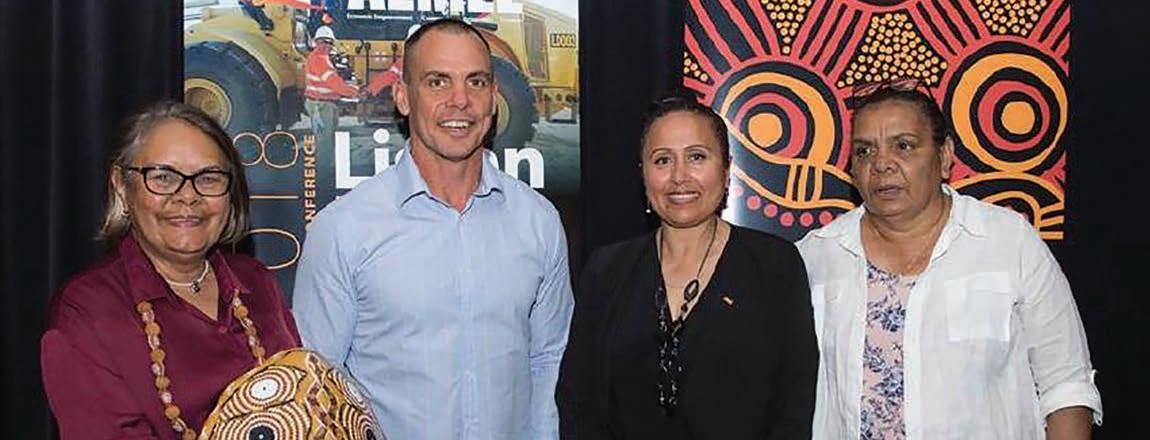
Sandra Miller, Derek Flucker, April Lawrie and Emily Ware at AEMEE Awards.
“I welcome the launch of the first Aboriginal Action Plan and I hope to see more engagement with traditional owners and to get a better understanding of what the South Australian government plans to achieve over the next two years. I certainly would praise a clear plan which supports native title groups and their economic potential” said Mr Thomas.
The new policy comes after the Government announced the discontinuation of the previous Labor Government’s Regional Authorities Policy.
The Regional Authorities Policy focussed on service delivery by region and supported established Aboriginal communities to negotiate and work closely with government on providing local services.
The Government’s Aboriginal Action Plan will be a positive force for Aboriginal “This plan provides opportunities for Aboriginal employment and decisionmaking and building the capacity of Aboriginal communities to manage their own affairs and engage effectively with government. “Collaboratively, the government and Aboriginal communities will pilot new and innovative activities for implementation across the state. It will enable us to draw on each other’s strengths and expertise, to deliver culturally-appropriate and community-driven services and programs,” the Premier announced on launching the plan.
A copy of the Action Plan is available at www.dpc.sa.go.au/ aboriginalaffairsactionplan
